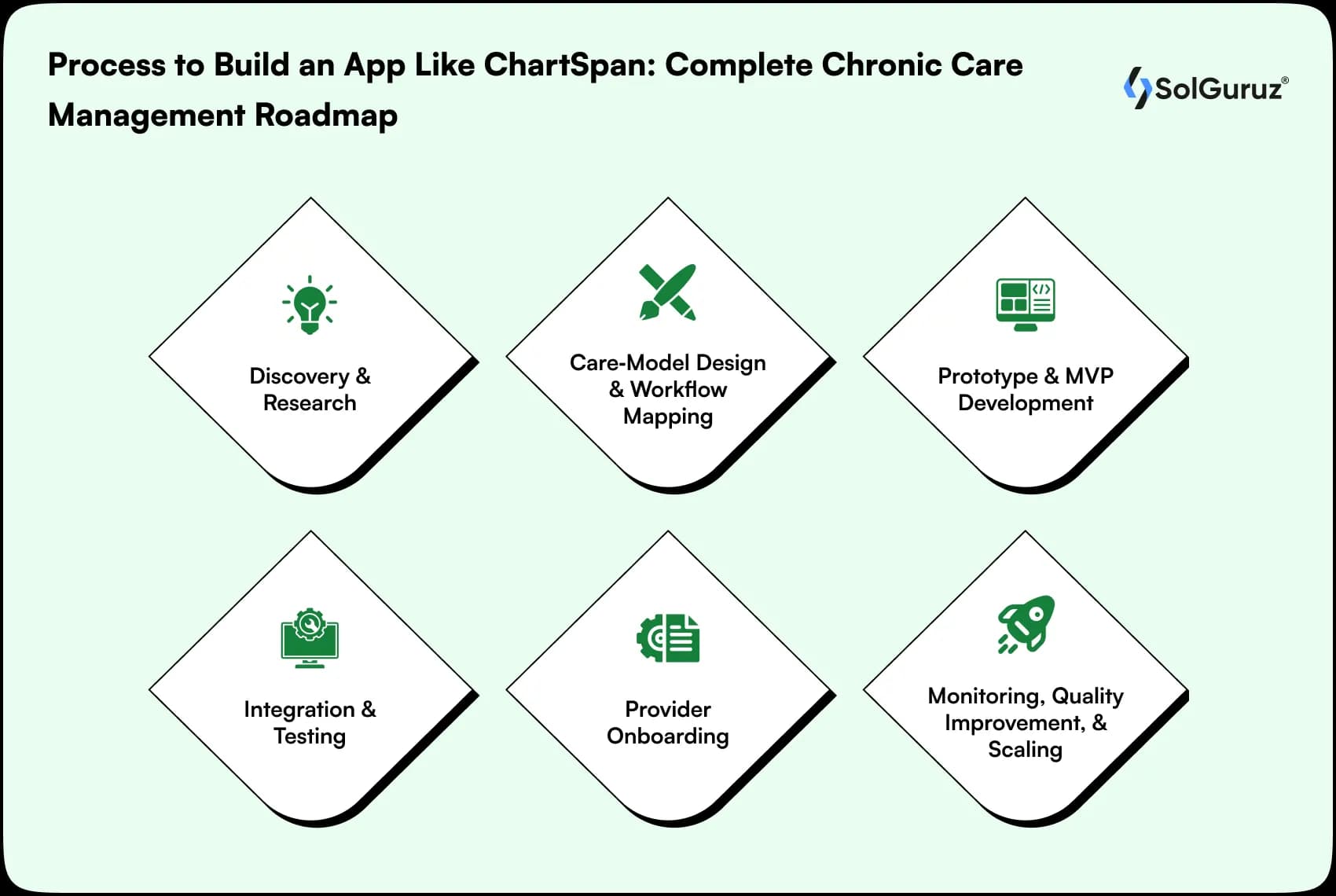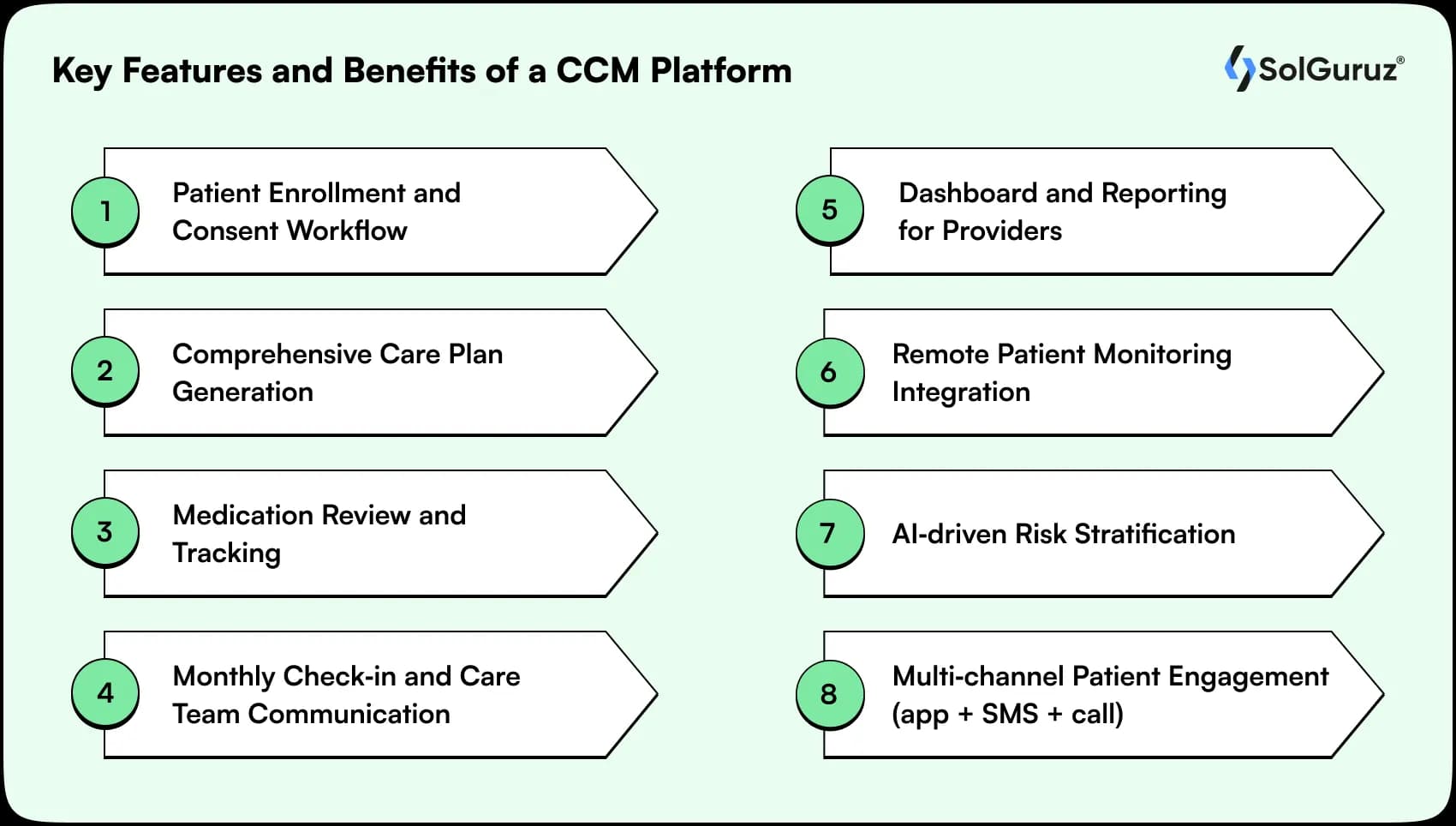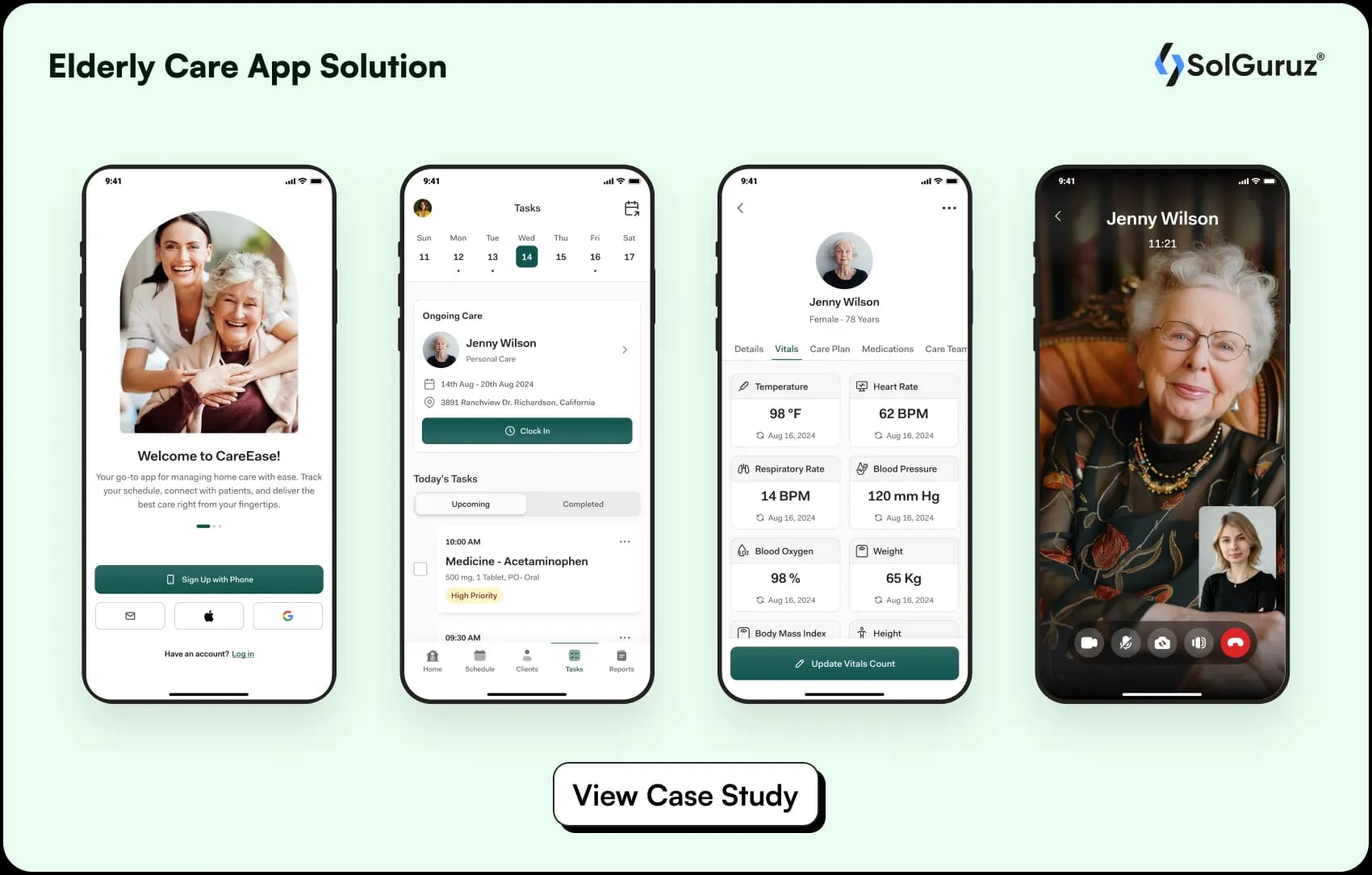How to Develop Chronic Care Management Software Like ChartSpan?
Chronic Care Management (CCM) is reshaping long-term patient care, and ChartSpan is a market leader. In this blog, you’ll read about how their platform works, what features your own CCM software should include, and how to build it step-by-step. We’ll cover the business model, advanced tech stack, pricing, compliance needs, and how you can differentiate your product in a growing market.

When Mary, a 67-year-old living in rural Georgia, was hospitalized three times in a year for COPD and diabetes, her clinic knew something had to change.
They launched a Chronic Care Management (CCM) program. Within months, Mary had a care plan, regular nurse calls, and remote monitoring. The result? Her hospital re-admissions dropped by 50%, and her quality of life improved dramatically.
Now imagine this – what if you could deliver personalized care, reduce readmissions, and unlock new revenue streams at scale, just like ChartSpan?
They’ve shown how powerful it can be to combine smart technology with care coordination. The good news? You don’t need a massive team or years of R&D to do the same. You just need the right roadmap – and the right partner.
This blog is a full development roadmap with tech stack, steps to develop, and cost to develop a chronic care management platform like ChartSpan.
Table of Contents
How ChartSpan’s CCM Program Works?
ChartSpan is a turnkey full-service CCM partner for clinics and practices that want to implement chronic care management (CCM). When building a CCM like ChartSpan, you don’t have to build everything in-house.
What do clients want?
Clients want someone who is aligned with their strategic clinical priorities and can work with them. Deliver them on their value-based outcome. Value-based care and care management.
They majorly focus on:
- Identifying the care gaps
- Taking appropriate steps that are proactive and preventative care goals to close those care gaps.
Types of services you can focus on:
- Compliance – ChartSpan provides the infrastructure to document non‑face‑to‑face interactions, link into the practice’s EHR, issue billing‑ready reports, and monitor quality measures.
- Admin – Great administration is part of any effective CCM. When you want to offer A-grade CCM and patient care, the administration should be on point.
- Enrollment – Enrolling new patients in the program. When they identify eligible patients and enroll them, digital enrollment makes it more convenient.
- Patient Care – Nurturing and educating patients about diseases. Patients enrolled in the program receive regular check‑ins, care‑plan follow‑ups, medication, and appointment reminders.
Types of Chronic Care Management Programs You Can Build

There are different types of CCM programs that work well. ChartSpan is a turnkey full-service CCM. Here are three more different kinds of CCM models you can opt for –
1. Full‑service CCM for practices, specialists, and large systems
What it involves:
Enrollment, care‑coordination staff, analytics platform, documentation, and billing support — all provided.
Clinic/practice acts as the “partner,” but much of the operational burden is with the vendor/platform.
Ideal for: Practices that lack internal infrastructure or want a turnkey solution.
Benefits: Faster time‑to‑market, predictable model, strong value story for the practice.
Trade‑offs: Requires a larger operational team, higher vendor cost, and may reduce provider control.
2. Niche CCM Programs (e.g., Diabetes Only, Heart‑Failure Only, Mental‑Physical Comorbidity)
What it involves:
Focus on a specific chronic condition or subset (e.g., heart failure, diabetes + depression, COPD)
Specialized workflows, tailored content, and condition‑specific remote monitoring.
Ideal for: Startups targeting a segment, or providers seeking a smaller‑scale program.
Benefits: Differentiation, easier to build domain expertise, and a strong marketing story.
Trade‑offs: Smaller patient base, may need deeper clinical specialization, narrower reimbursement scope.
3. Technology‑Enabled CCM vs Lean CCM
Technology‑Enabled CCM: Includes remote patient monitoring (RPM), mobile app for patients, predictive analytics, and AI‑driven insights.
Pros: Higher value‑added, better outcomes, premium pricing potential.
Cons: More complex tech stack, device management, and integration challenges.
Lean CCM (Care Coordination Only): Focuses on care‑manager calls, tasks, documentation, and physician coordination – lower tech footprint.
Pros: Faster launch, lower dev cost, simpler compliance scope.
Cons: Less differentiation, lower margin potential, harder to scale premium value.
4. Web vs Mobile vs Hybrid App Models
Web‑based portal only: Providers use a browser interface; patients may be managed via phone. Quick to build, but limited patient engagement.
Mobile app for patients + web portal for providers: Better patient experience, higher engagement, but higher cost and complexity.
Hybrid (responsive web + mobile app): Balanced approach, can launch web‑first then mobile.
When building your CCM platform/solution, decide on the model based on your target audience –
- Are you targeting older patients, 🡪 mobile‑light
- Or tech‑savvy patient groups 🡪 are mobile-heavy
Are providers expecting mobile access?
Process to Build an App Like ChartSpan: Complete Chronic Care Management Roadmap

If you are serious about building a chronic care management program like ChartSpan, you need a clear roadmap. Here is one for you-
Phase 1: Discovery and Research
- First, define which patient groups you want to cater to. Understand what qualifies for CCM reimbursement from Medicare or Medicaid services or your local healthcare authority.
- Interview clinicians to understand their pain points and workflow.
- Research the competitors.
- Gain knowledge about the compliance in your local region.
When in doubt, you can always consult a custom healthcare software development company to help you with the queries.
Phase 2: Care‑Model Design and Workflow Mapping
- Map out patient engagement journeys, like how the monthly reminders will be, via calls or messages. Basically, how will you navigate the patient in their care journey?
- Define your care coordinator workflow with documentation, processes, etc.
- Align your software’s logic with billing codes and audit requirements.
Point to remember – Don’t forget to incorporate touchpoints for care plan review, physician approval, and automated reporting.
Phase 3: Prototype and MVP Development
- Design your MVP to cover core workflows like patient intake, monthly tracking, task management, and provider reports. You must avail expert MVP development services to design a flawless MVP that can get investors’ attention.
- Decide user types – care providers, patients, and others.
- Create wireframes and a clickable prototype.
- Make accessibility a prime feature, which works well, especially for elderly patients.
Phase 4: Integration and Testing
- Integrate with electronic health records (EHR) with standards like HL7.
- If you want wearables, then add device integrations for wearables like blood pressure cuffs.
- Do not forget testing – Use sandbox environments for secure testing. Conduct load testing, penetration testing, and usability testing across devices.
Phase 5: Provider Onboarding
- Start small and practice piloting the solution.
- Run training sessions and create onboarding kits for providers.
- Next, there is customer success and feedback. Take feedback to improve the system.
Phase 6: Monitoring, Quality Improvement, and Scaling
- Track KPIs like the number of enrolled patients and reduced ER visits.
- Automate care plans, reporting, and renewals.
- Build advanced features like AI-driven care suggestions to make the program stand out and more sophisticated.
Key Features and Benefits of a CCM Platform

A robust chronic care management (CCM) platform should serve providers, patients, and care teams efficiently. Listed below are features that you should have in your CCM(core features) and features that can improve your CCM (advanced features)
Features List (must have)
You need a smart and robust CCM. These are the features you must add-
1. Patient Enrollment and Consent Workflow
Enrolling patients digitally in the CCM program. Get proper consent and track them with this feature. Auto-check eligibility and log consent timestamps for audit readiness. It reduces onboarding friction and saves time.
2. Comprehensive Care Plan Generation
This feature helps in generating personalized care plans based on the patient’s chronic disease and care goals. Care plans should be editable, shareable, and easy to review. It empowers proactive patient care.
3. Medication Review and Tracking
You can record current meds and flag interactions. Also, you can send refill reminders so no medication is missed. It is a good idea to sync with pharmacy systems or EHRs for accuracy. This not only reduces medication errors but also improves adherence.
4. Monthly Check‑in and Care Team Communication
Add a feature where the care coordinators log at least 20 minutes of monthly interaction. This enhances communication between care coordinators. Also providing an option to support calls, messages, and video check-ins. It satisfies CMS billing and supports ongoing engagement.
5. Dashboard and Reporting for Providers
A dashboard to visualize all the metrics in one place. That includes visualizing patient panels, care progress, and performance metrics. With this dashboard, you can track staff workload, billing status, and potential reimbursement. It boosts provider visibility and billing efficiency.
6. Remote Patient Monitoring Integration
This feature enables remote monitoring for patients, making remote care more accessible. You can sync vitals from wearables like BP cuffs, glucose monitors. A feature for auto-trigger alerts and care plan updates. Beneficial with real-time insights.
7. AI‑driven Risk Stratification
Using AI/ML to flag high-risk patients, so they get immediate care. AI technology also helps analyze patient data and understand patient categories. With the help of AI, you can prioritize outreach and optimize staffing. It increases efficiency and reduces hospital readmissions.
8. Multi‑channel Patient Engagement (app + SMS + call)
This feature allows patients to interact via app or messaging or call. It increases engagement and makes the care available at your convenience.
9. Interoperability with EHR and Third‑Party Systems
You can add this feature to improve third-party interoperability, like Epic and others. HL7/FHIR compliance for structured health data exchange. Seamless workflows and reduced duplicate entry.
10. Region-Specific Compliance & Data Privacy Features
Support for region-specific compliance, like UK GDPR, EU MDR, and others. Localized hosting options like AWS, etc., work well. It builds patient and provider trust across boundaries.
Tech Stack for CCM Platform Development
- Front‑end: Web portal (React / Angular), Mobile (React Native or Flutter)
- Back‑end: Node.js / Python / .NET – microservices for scalability
- Database: PostgreSQL + Redis or MongoDB (for flexible data)
- Integrations: EHR APIs, device APIs
- Security & Compliance: GDPR, HIPAA
- Infrastructure: Cloud (AWS/Azure) + DevOps/CI‑CD
- Hybrid model: partner services (third‑party CCM like ChartSpan vs building in‑house)
This is the tech stack you can use to build chronic care management like ChartSpan. If you want to integrate AI, then a skilled AI development service can help you with quick integration.
It is a good idea to build a cross-platform healthcare app. You can hire cross-platform app developers who are experts in developing a healthcare app that works seamlessly on all platforms.
Cost, Timeline & ROI Estimation
The most emphasized question during our conversations with clients is – “What is the cost of developing a chronic care management platform like ChartSpan?”
We understand this query is natural, so here we are answering it with a table including the timeline to give you an approximate idea.
| Build Stage | Approx. Cost (USD) | Timeline | What’s Included |
| MVP (Basic CCM App) | $10,000 – $30,000 | 2–4 months | Patient registry, task manager, coordinator login, basic reports, secure messaging |
| Mid-Level Platform | $40,000 – $75,000 | 5–7 months | EHR integration, remote monitoring (optional), HIPAA/GDPR compliance, and billing tools |
| Full-Service CCM | $100,000 – $150,000+ | 8–12 months | AI alerts, care plan automation, audit trails, multi-provider access, full reporting |
| AI + RPM Add-ons | $10,000 – $30,000+ | Varies | Wearables integration, AI risk scoring, trend-based intervention triggers |
| Ongoing Maintenance | $3,000/month+ | Continuous | Feature updates, compliance support, server costs, security patches, tech support |
Developing a basic or complex healthcare software solution has features. It goes with the understanding at your side and ours that the more features you are going to add, the higher the cost will be. You can always sit and discuss with the healthcare software development company that is developing your software.
ROI drivers
Where there is cost, there is Return. And where there is Return, there is ROI. Below are four factors that drive ROI in a chronic care management platform. This is where you can make your best bet.
- Fewer admissions,
- Improved reimbursement,
- Better quality metrics
- Local reimbursement models in the US and the UK
Differentiation Strategy: How to Build a Better Version Than ChartSpan
To develop chronic care management like ChartSpan is one thing, but to stand out and carve your niche in the market is another.
What Can You Do Better?
| ChartSpan Offers | You Can Do Better By… |
| Broad services | Niche-first, underserved populations |
| CMS-focused | UK/EU healthcare focus |
| Manual workflows | Smart AI-based predictions |
| Basic dashboards | ROI & compliance auto-reporting |
| Generic UX | Simplified UX for older & rural patients |
To outperform a well-established CCM provider like ChartSpan, you need to strategically position your product as a next-gen chronic care platform.
One that not only matches core functionalities but also bridges the real care gaps ChartSpan leaves open.
1. Focus on Underserved Segments
ChartSpan serves a broad spectrum of chronic disease-affected populations, but many niche and rural markets remain overlooked.
How to Differentiate –
- Rural Patients – Build features that support low-bandwidth access, telephone-based care plans, or local clinic integrations.
- Mental + Physical Chronic Conditions – You could add mental or behavioral health modules like PHQ-9 assessments, therapist notes, into chronic disease workflows for holistic CCM.
- Ethnic & Cultural Care Models – Include multilingual support to make it well accepted in different geographies. Culturally sensitive onboarding and region-specific content will also work.
Example–
“A diabetes + depression management platform tailored to rural UK patients could win both compliance and contracts.”
2. Leverage Localized Data & Regional Compliance (UK/EU)
ChartSpan is US-based and optimized for CMS (Centers for Medicare & Medicaid Services) billing. So that leaves the globe as an opportunity for you. You could focus on UK or EU-based care management platforms.
How to Differentiate-
- Target private UK clinics with a solution that supports UK-specific billing codes and Quality and Outcomes Framework measures.
- Use GDPR-first architecture.
- Integrate local health data sources like NHS Digital to inform population-level insights.
Example –
“Offering a CCM app optimized for QOF compliance and GDPR could instantly resonate with UK practices.”
3. Integrate Cutting-Edge Tech from Day One
ChartSpan is strong on workflows but lacks deep tech integration.
How to Differentiate-
- Wearables Integration- Partner with Fitbit, Apple Health to bring real-time biometric tracking into the care plan.
- AI-Powered Alerts and Care Coordination- Use machine learning for risk scoring, missed appointment predictions, or early deterioration alerts.
- Voice-to-Text and NLP- Allow care team members to dictate notes, automatically extracting symptoms.
Example–
“Imagine if a nurse could be alerted when a patient’s sleep drops for 3 nights – an intuitive system will work wonders.”
4. Build Patient-Centric UX (Especially for Older Users)
A major friction point in current platforms is the complex user experience, especially for seniors or caregivers.
How to Differentiate-
- Voice interface options for visually impaired patients.
- Larger buttons, simplified flows, and minimal screens.
- Caregiver logins to allow family involvement (e.g., a daughter tracking her father’s care).
- Real-time chat or “Call a nurse” button for reassurance.
Example-
“You can be the ‘Whatsapp of CCM’ – one-touch check-ins, emoji feedback, simple reminders that older users can effectively use.”
In these ways, you can make your place in the chronic care market.
Now is the Time to Invest in Chronic Care Management
Chronic conditions like diabetes or depression are gradually increasing, and so is the burden on healthcare systems. Now is the perfect time to invest in this market.
Here is the perfect checklist that you need to launch your chronic care management platform like ChartSpan.
Whether you’re a digital health startup or an established provider network, starting early means you can test, iterate, and scale before the market crowds up.
Struggling with care model workflows? Which tech stack fits compliance needs?
SolGuruz has helped healthcare innovators build, launch, and scale CCM platforms with powerful dashboards, clean UX, and rock-solid security.
From MVP to full-scale products – we help you turn your chronic care vision into a measurable reality.
FAQs
1. What Conditions Qualify for CCM?
Patients qualify for CCM if they have two or more chronic conditions for more than 12 months. Conditions like diabetes, depression, COPD, Hypertension, Arthritis, and others.
2. How Do Providers Get Reimbursed for CCM?
Providers get reimbursed monthly through their CPT codes. In the USA, the CPT codes 99490, 99439, and 99491 are based on time spent managing patient care outside of face-to-face visits.
3. What Technology is Needed to Build a CCM Program?
To build a scalable CCM program, you need a patient-friendly mobile or web app, a provider dashboard, and secure calling/messaging systems.
4. What are the Main Regulations for CCM Programs in the UK/EU?
The CCM platform must comply with GDPR, NHS, and Data hosting regulations. There are other compliances as well to protect patient data, privacy, and legal compliance.
5. Can you use Telehealth/RPM in CCM?
Yes. It is highly recommended. Telehealth allows monthly video calls and secure chats. Remote patient monitoring lets providers check on vitals in real-time.
Build Your ChartSpan-Like CCM Platform
Turn your CCM idea into a real, revenue-ready product.

Strict NDA

Trusted by Startups & Enterprises Worldwide

Flexible Engagement Models

1 Week Risk-Free Trial
Give us a call now!

+1 (724) 577-7737



